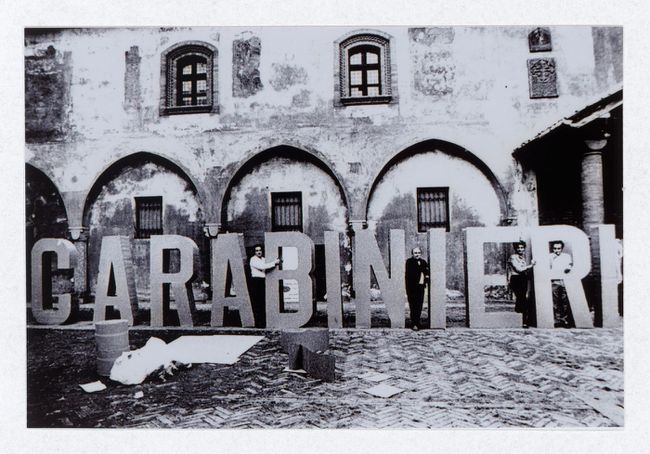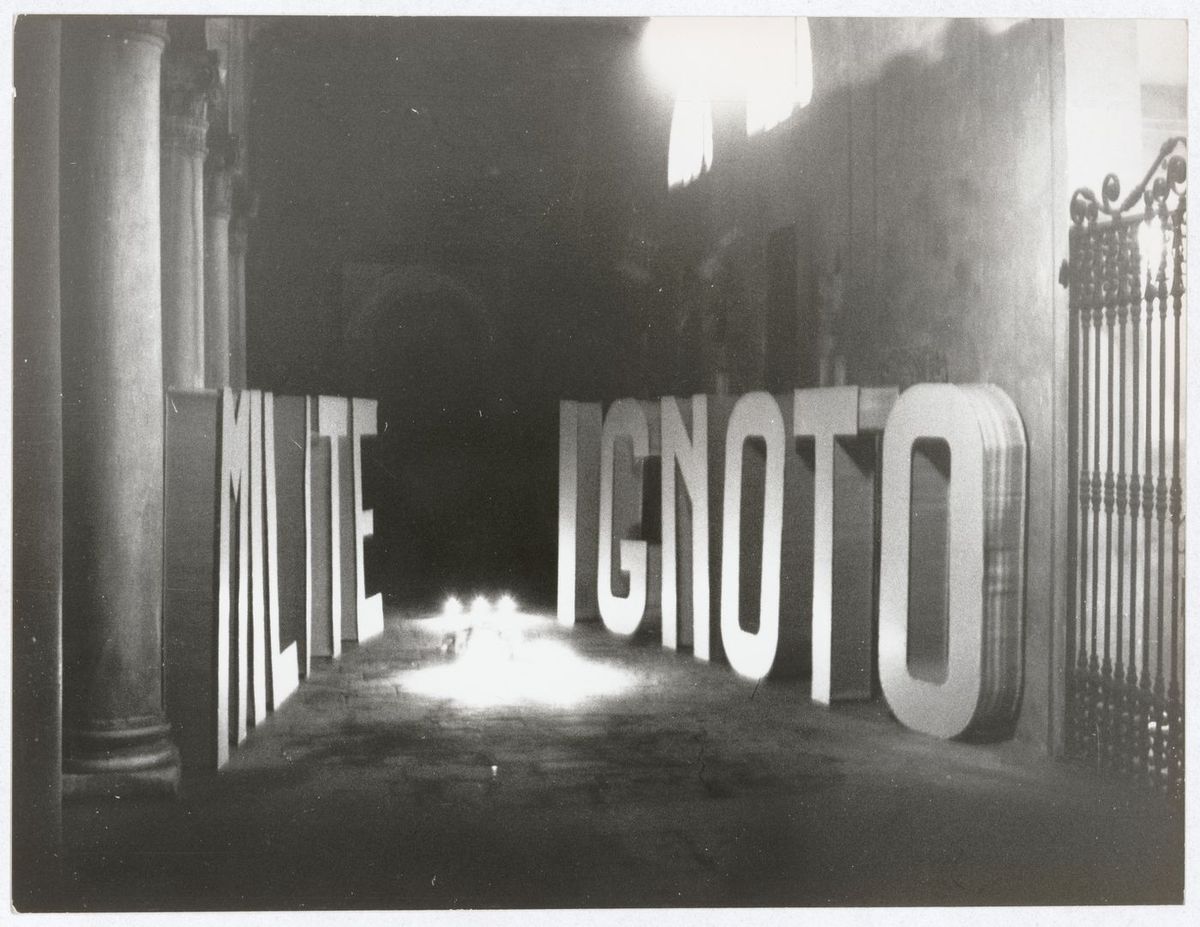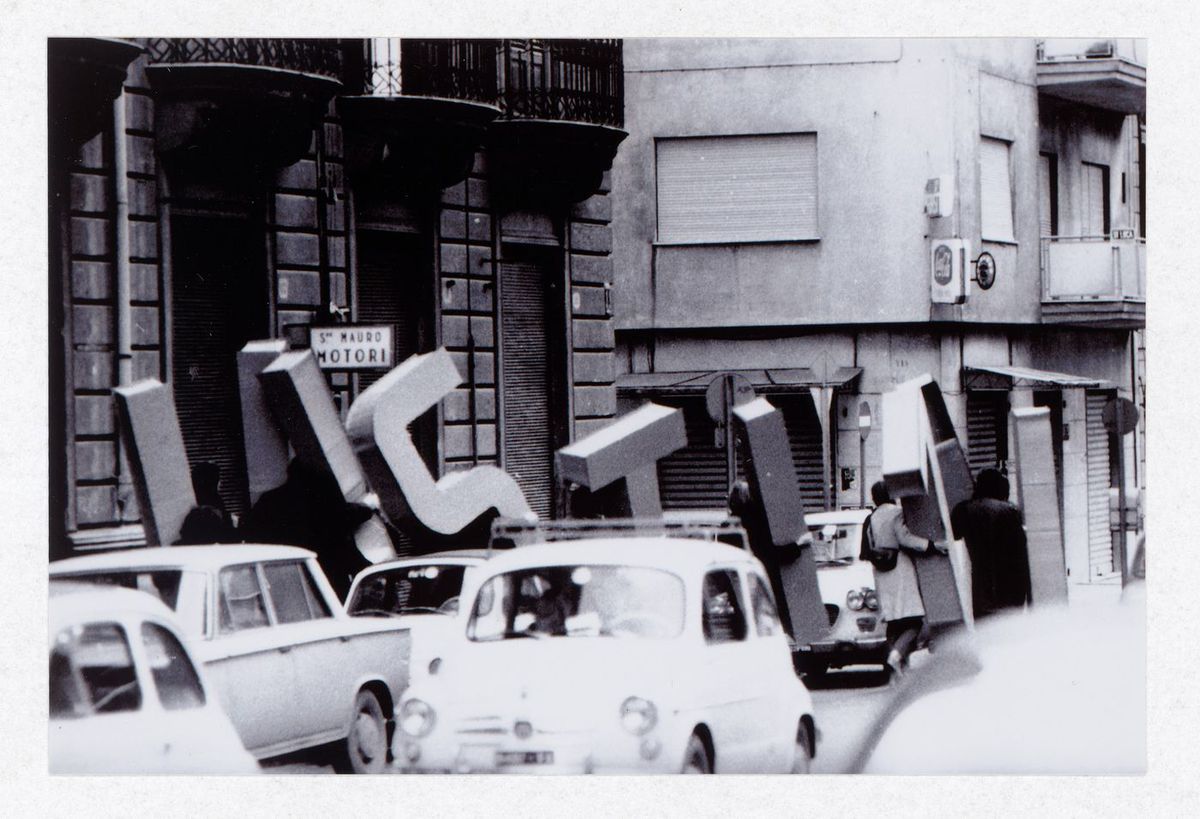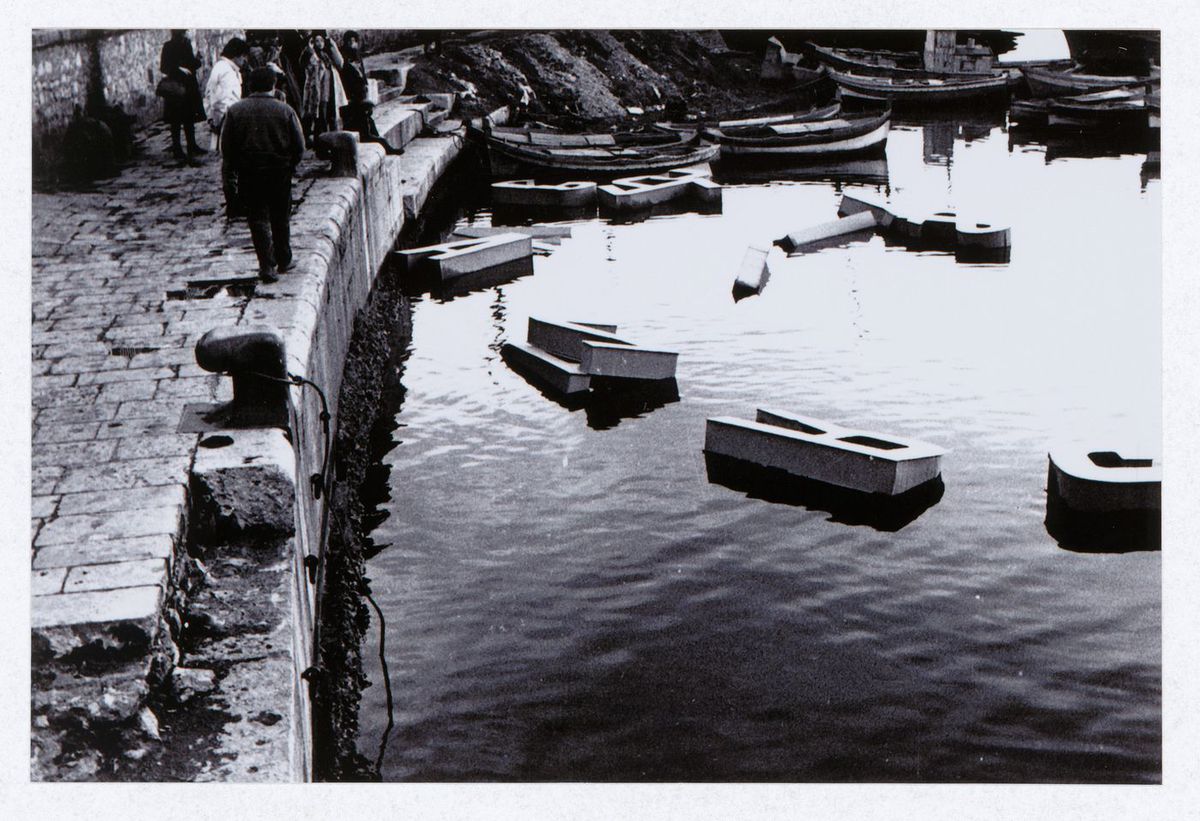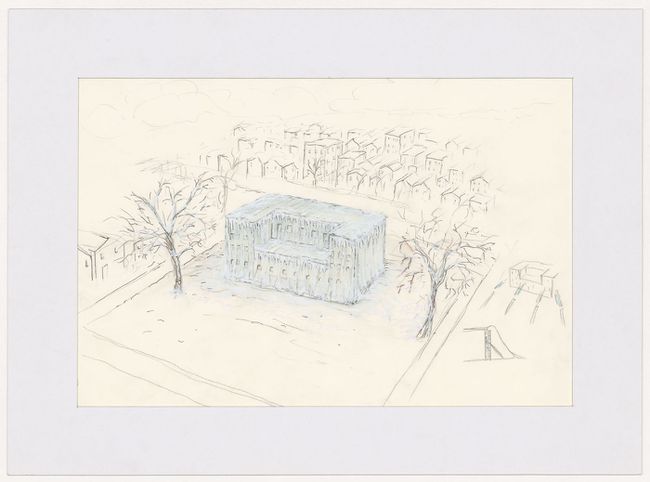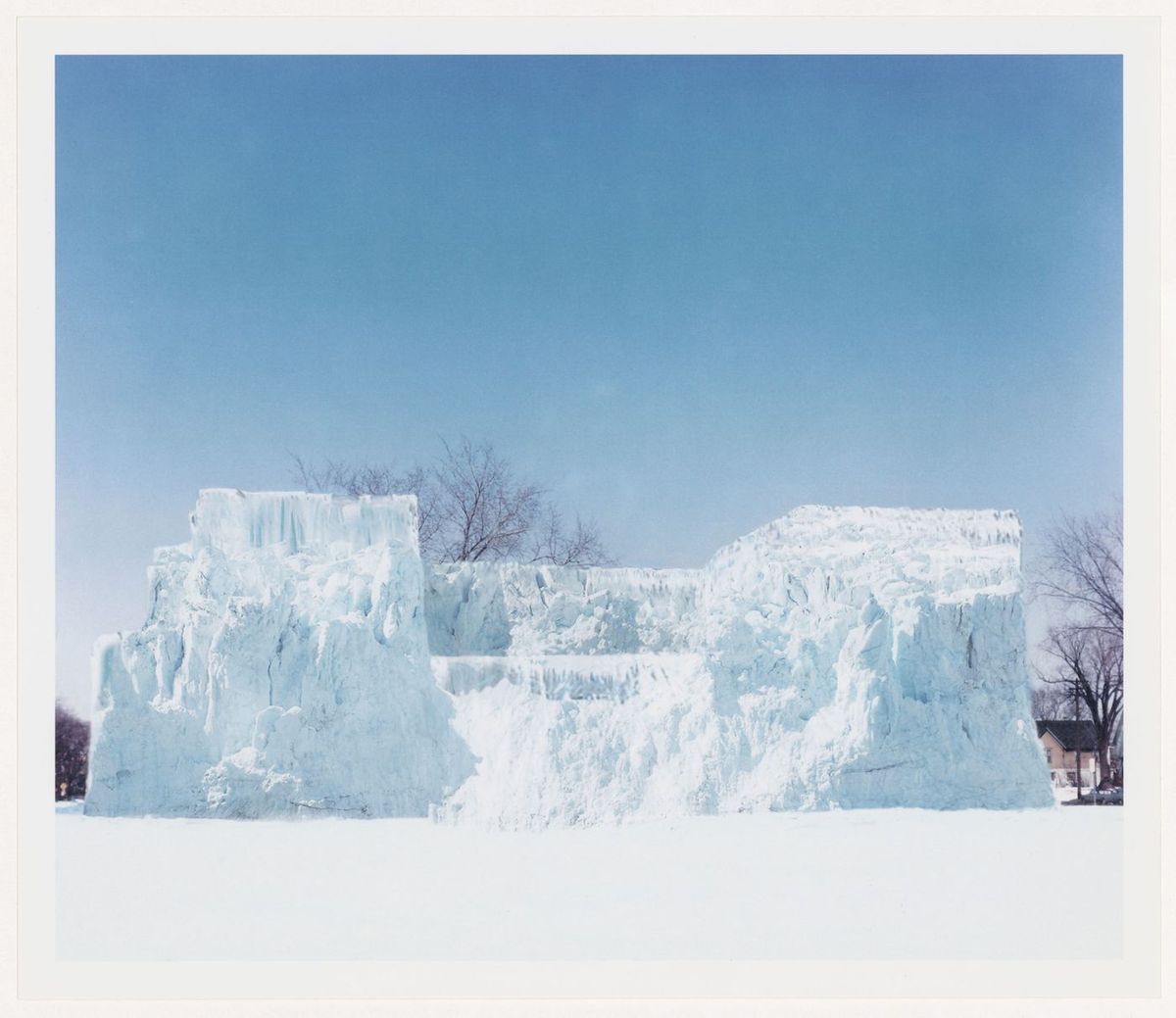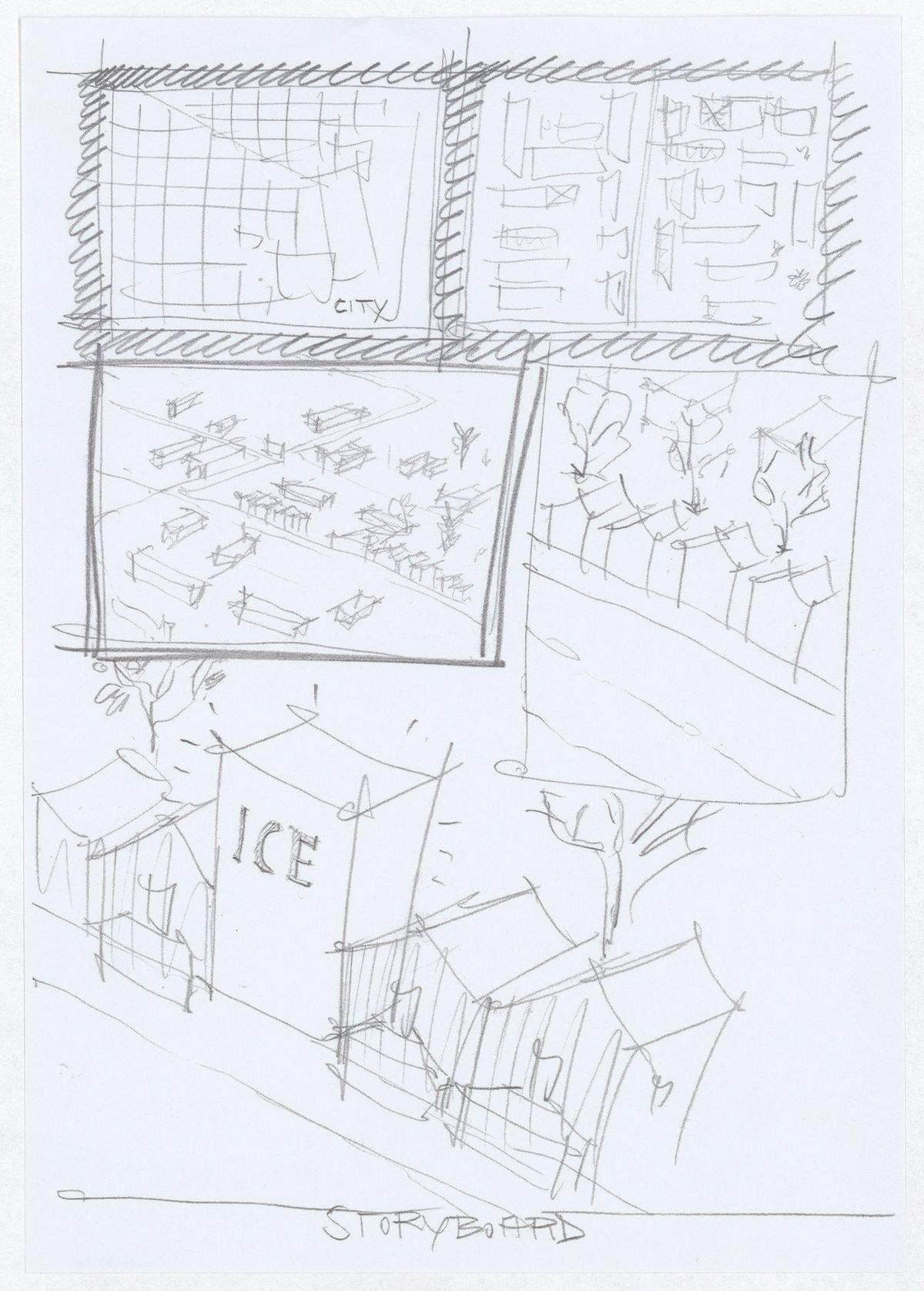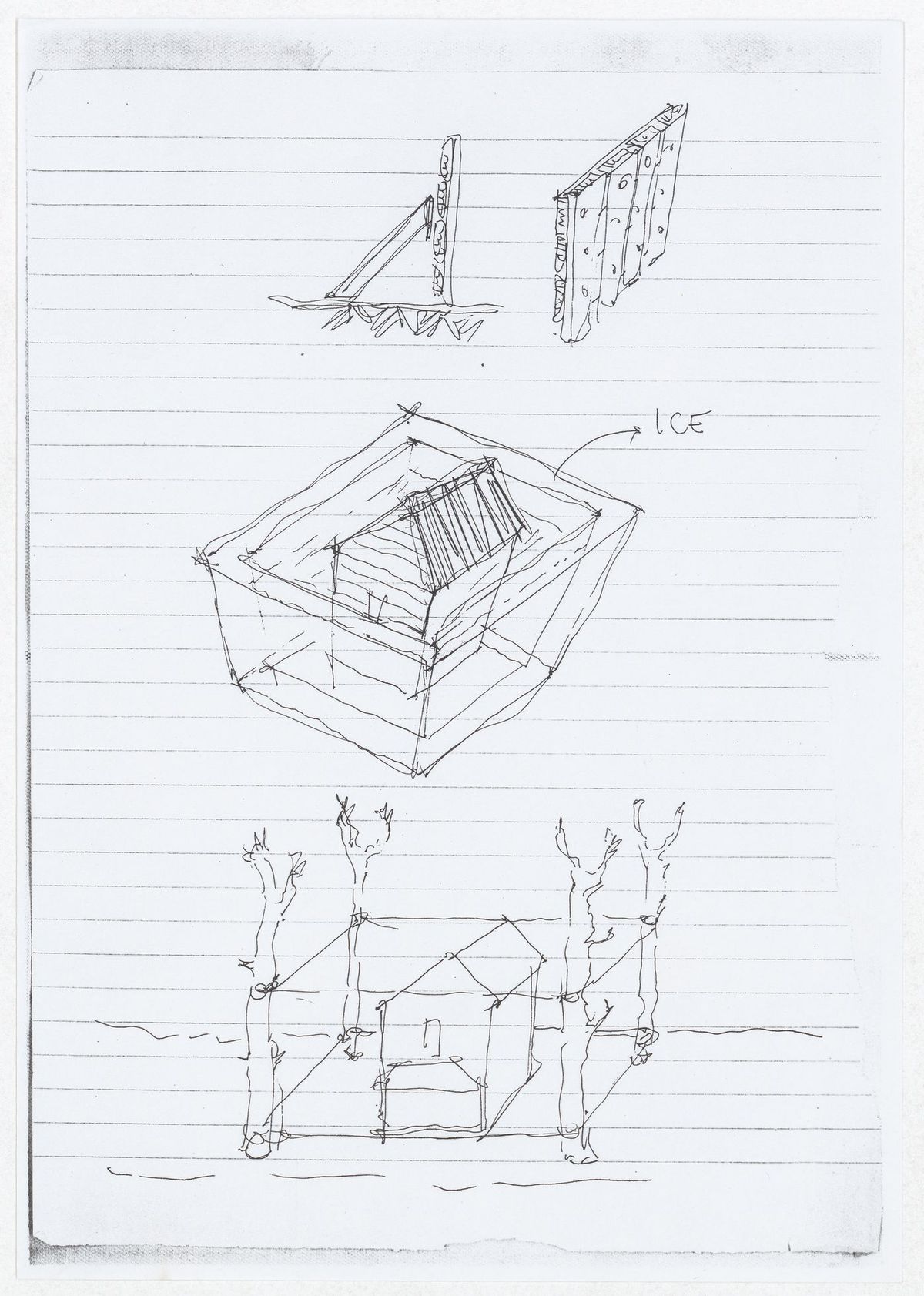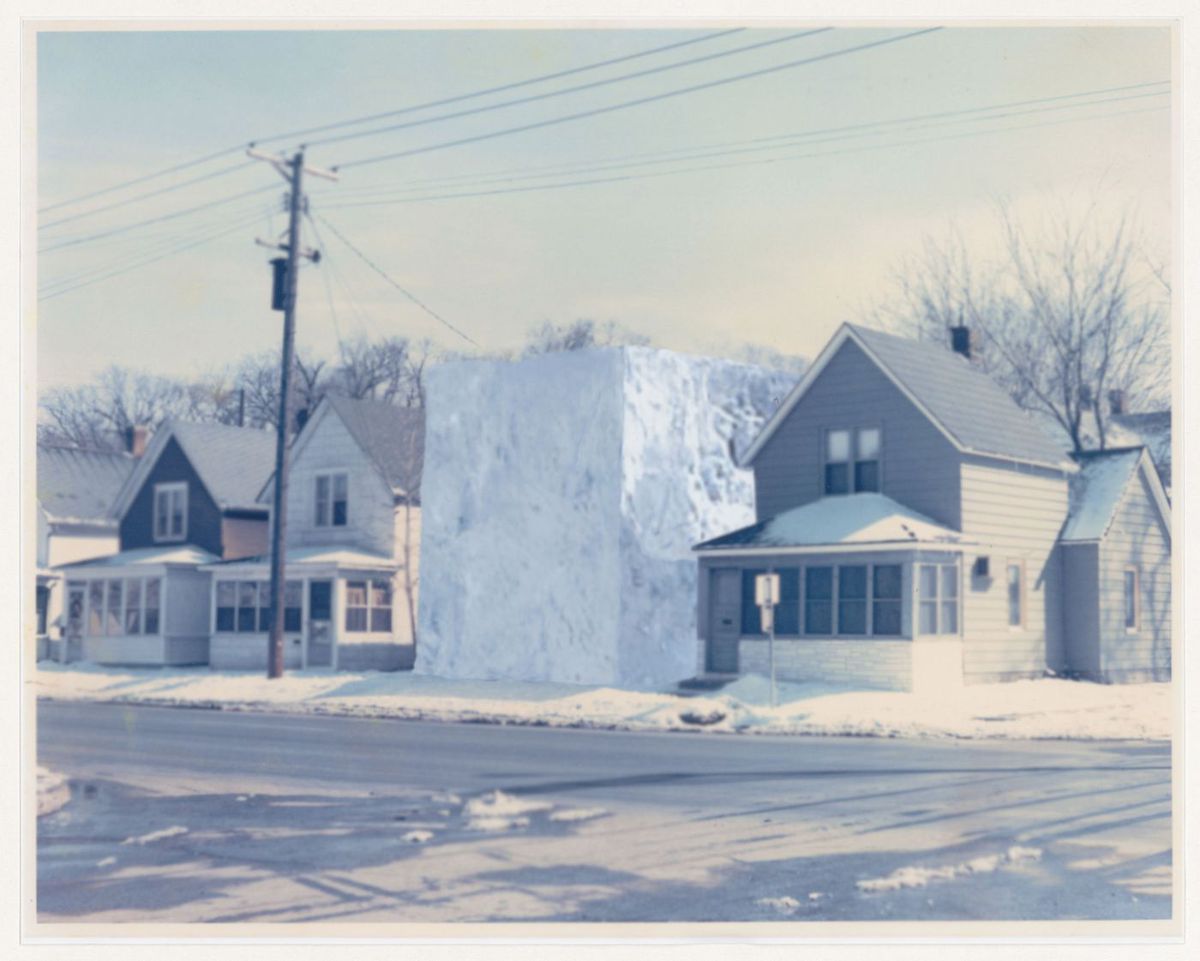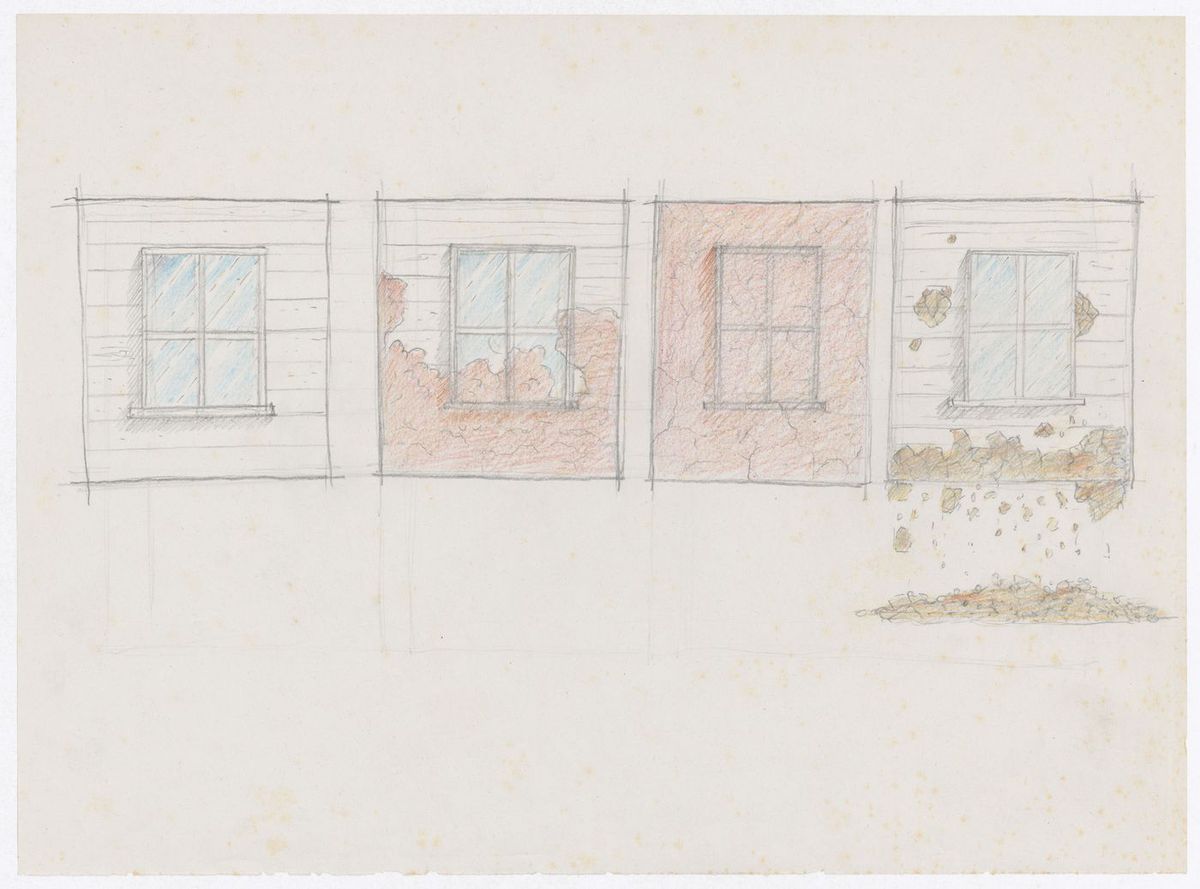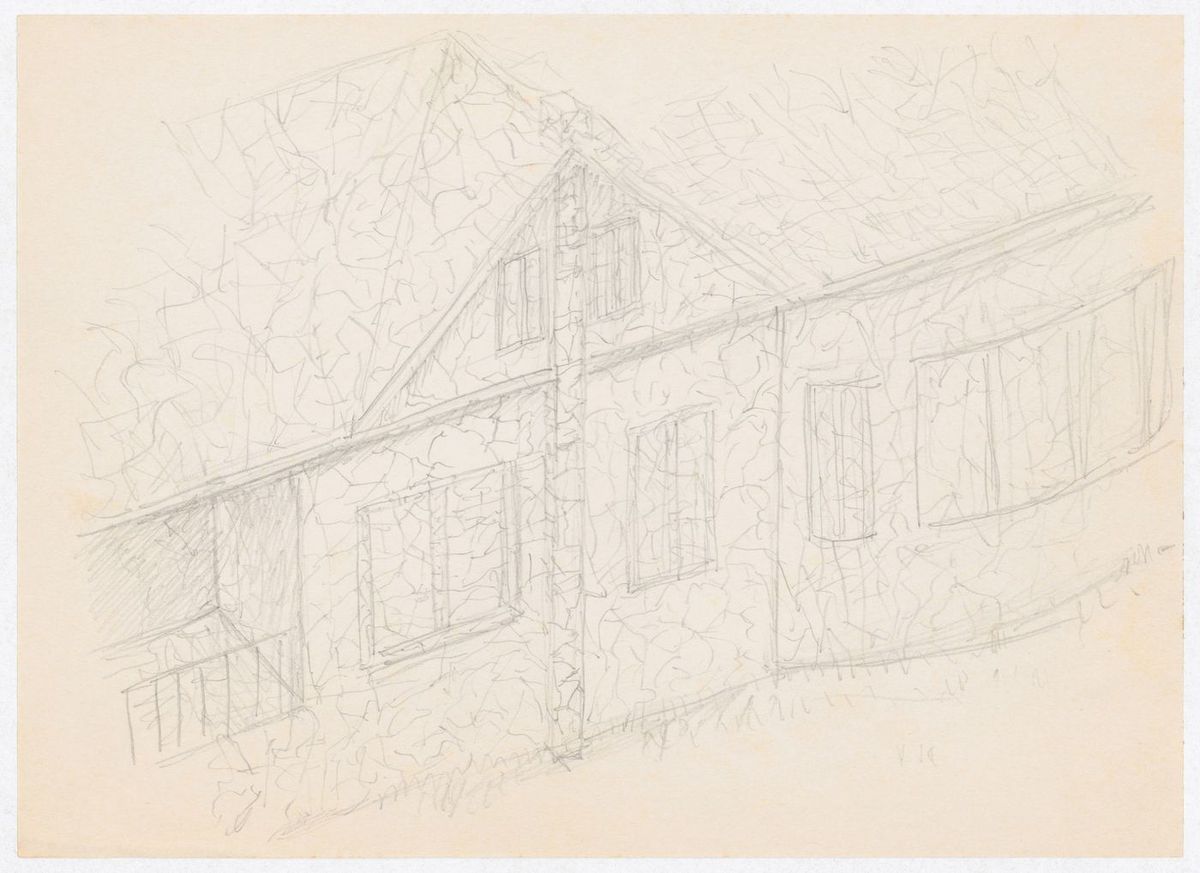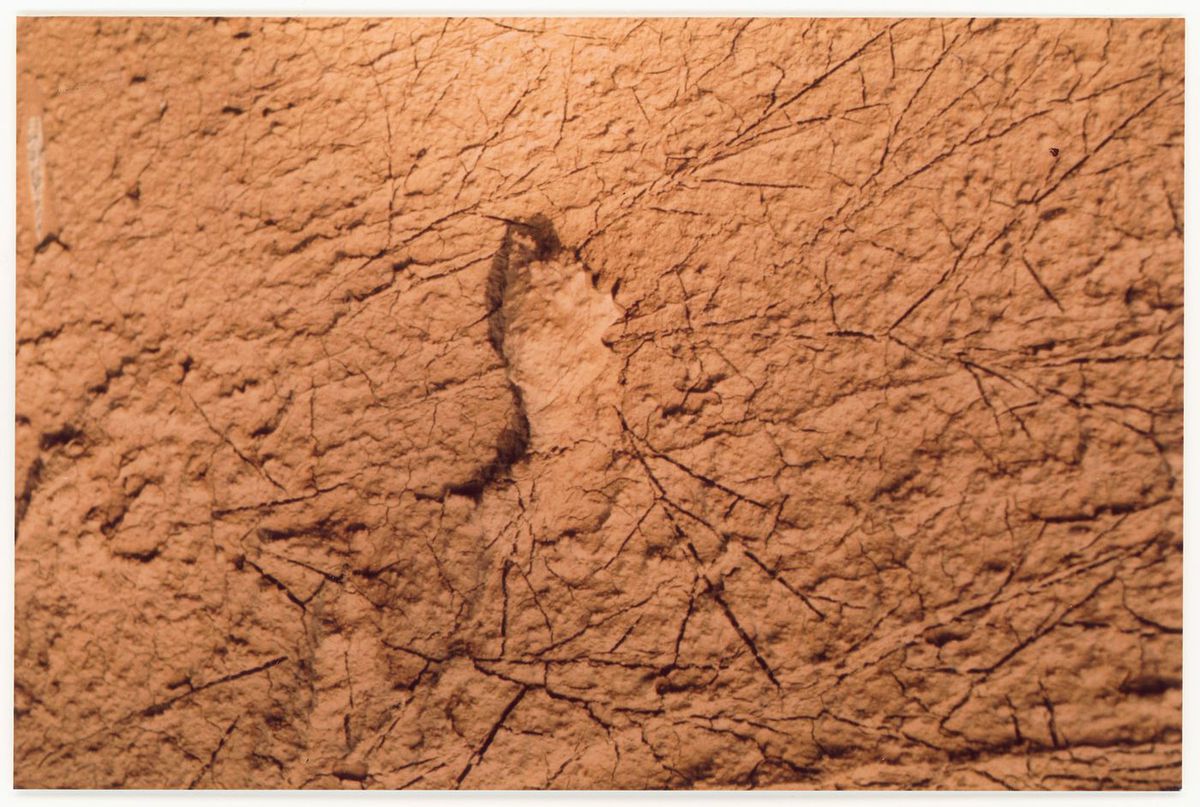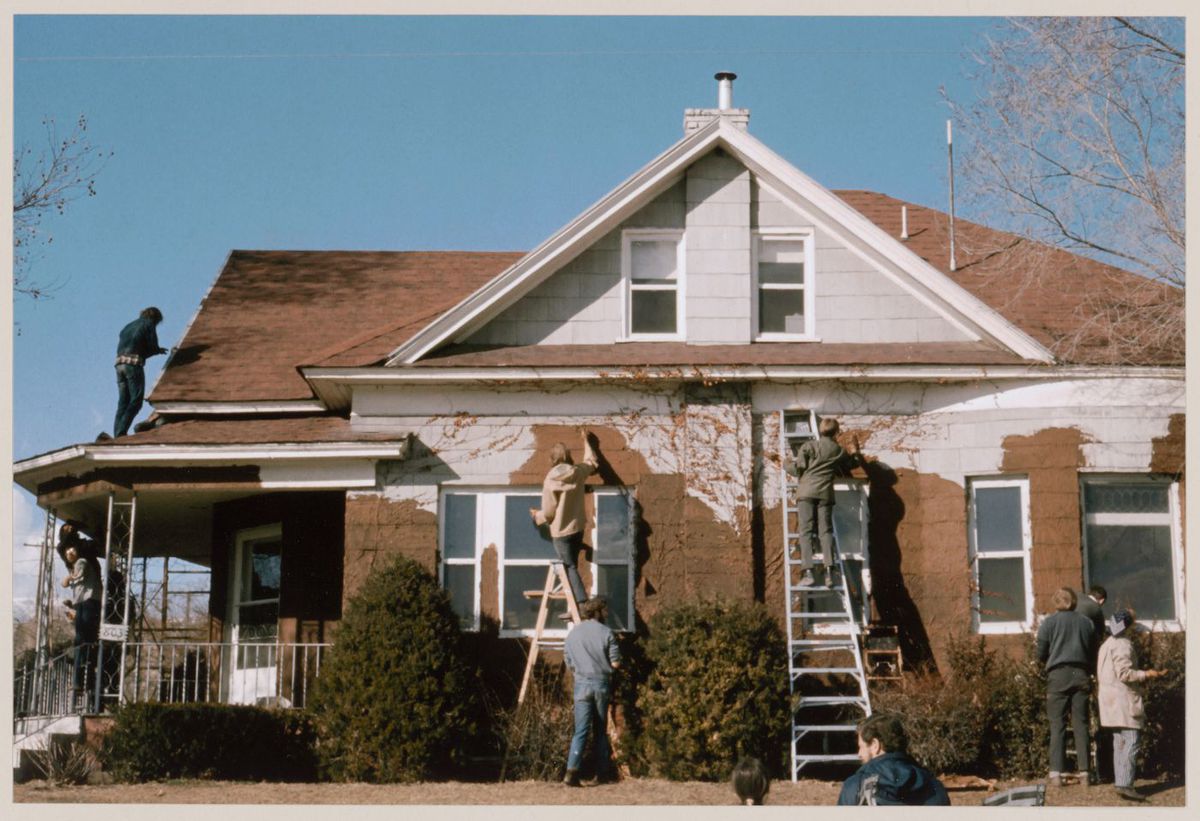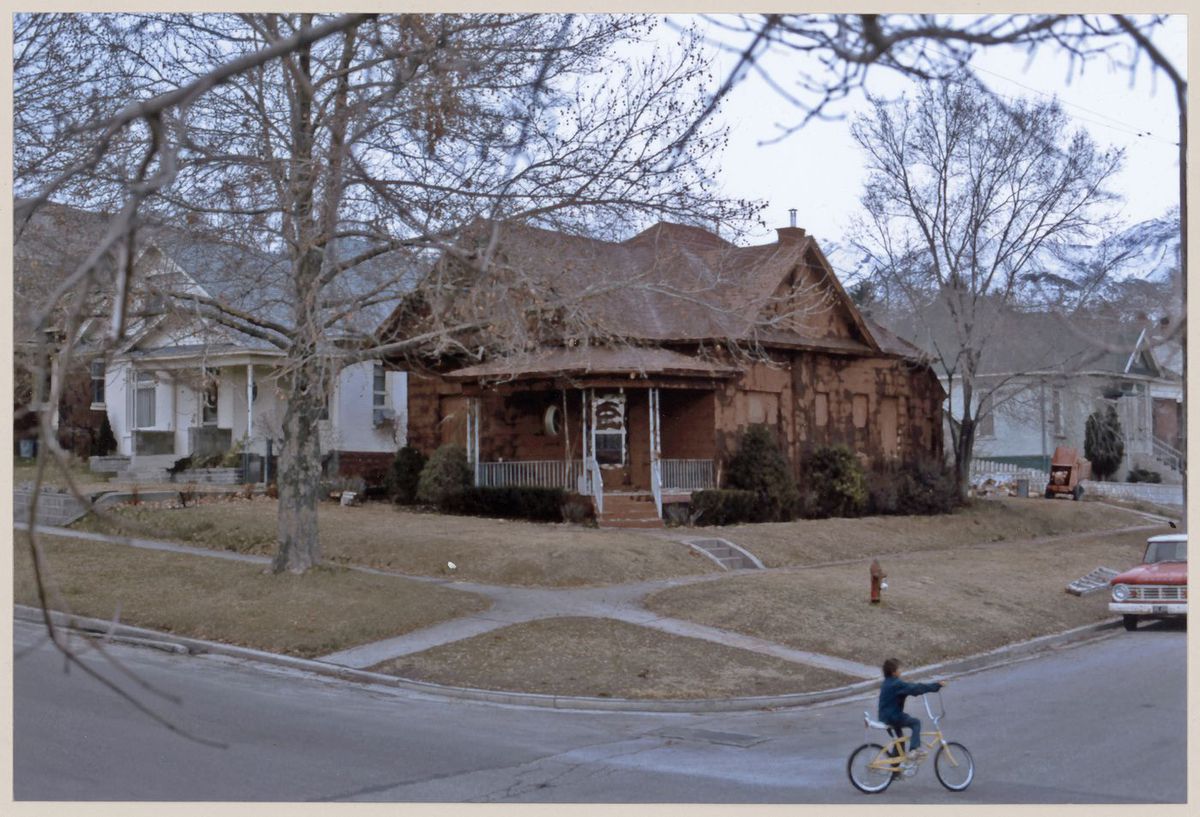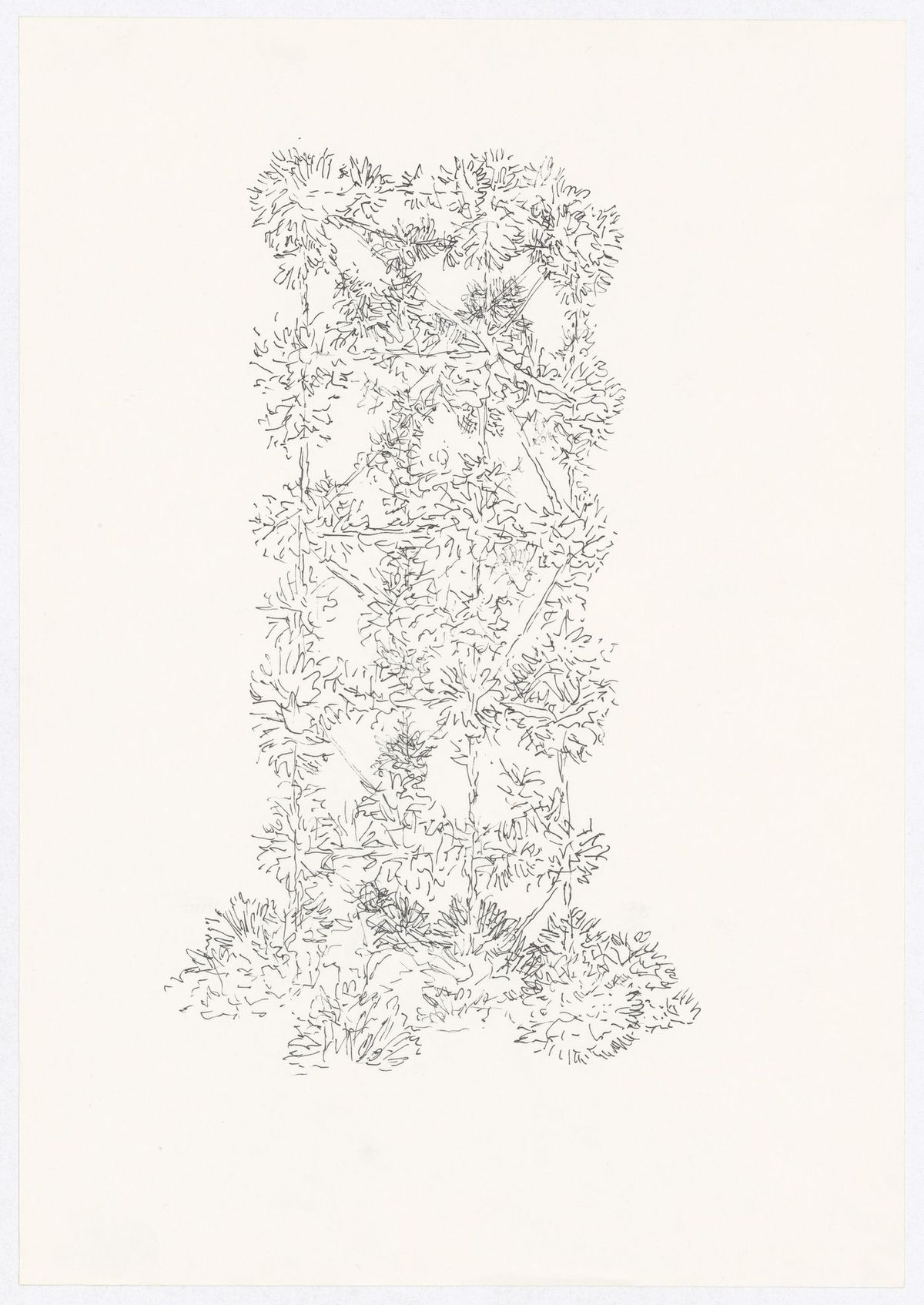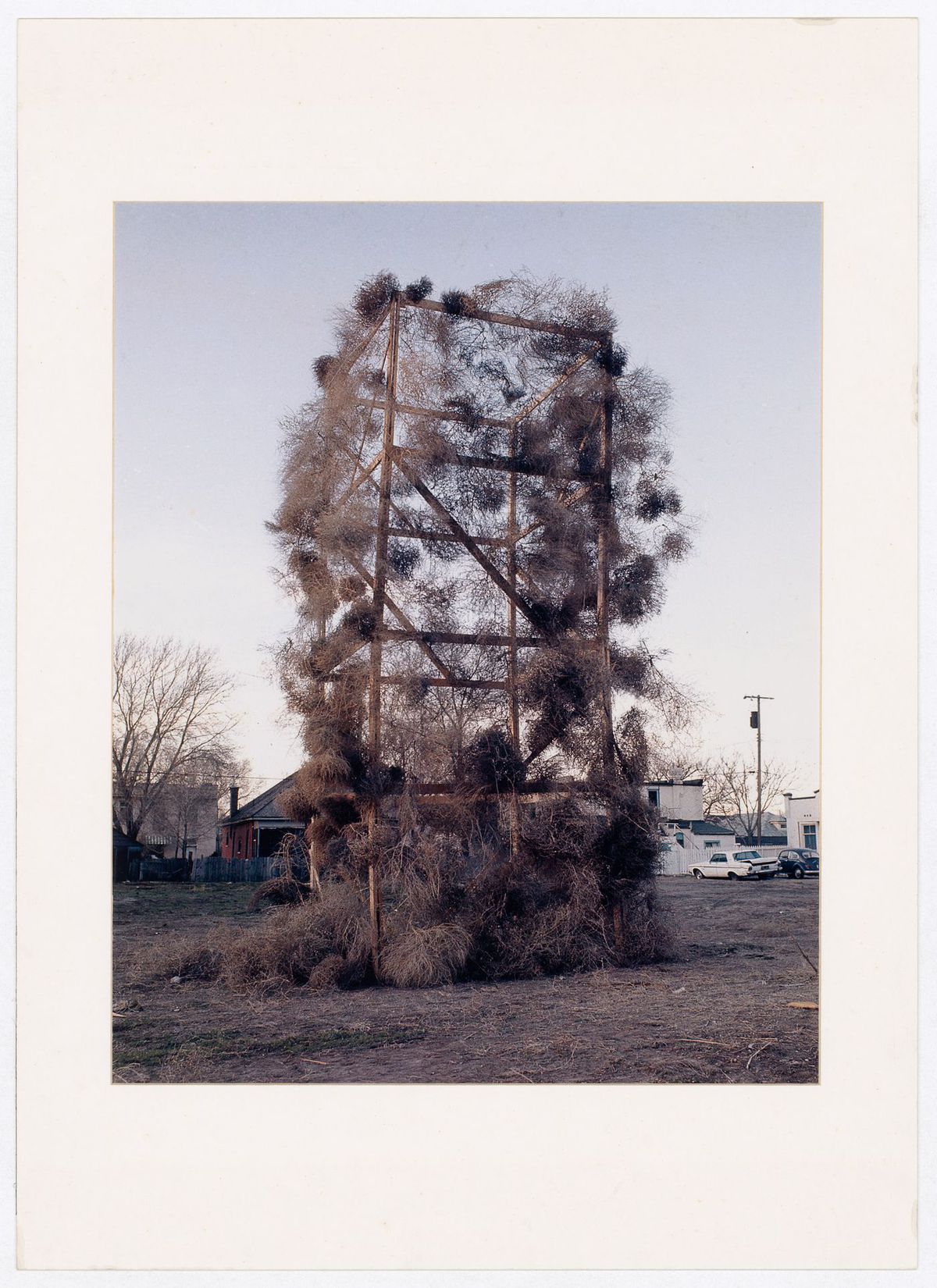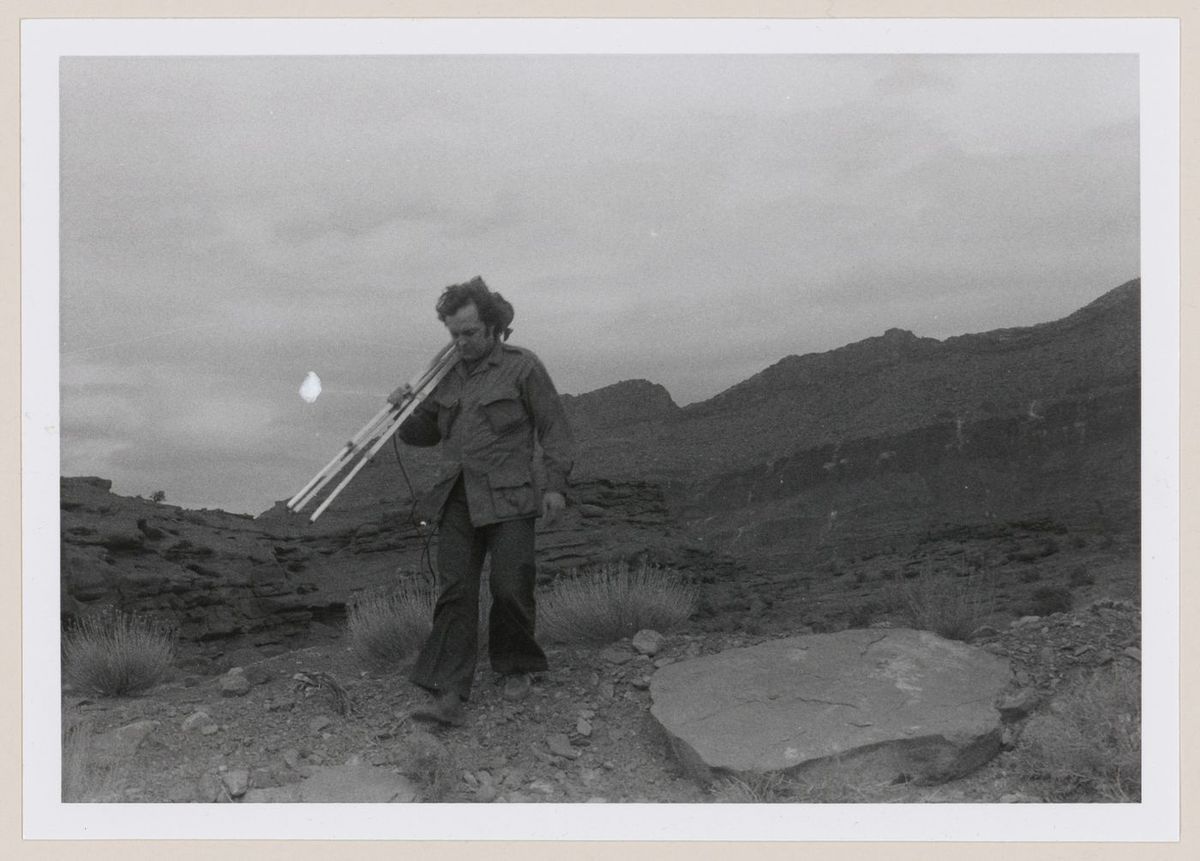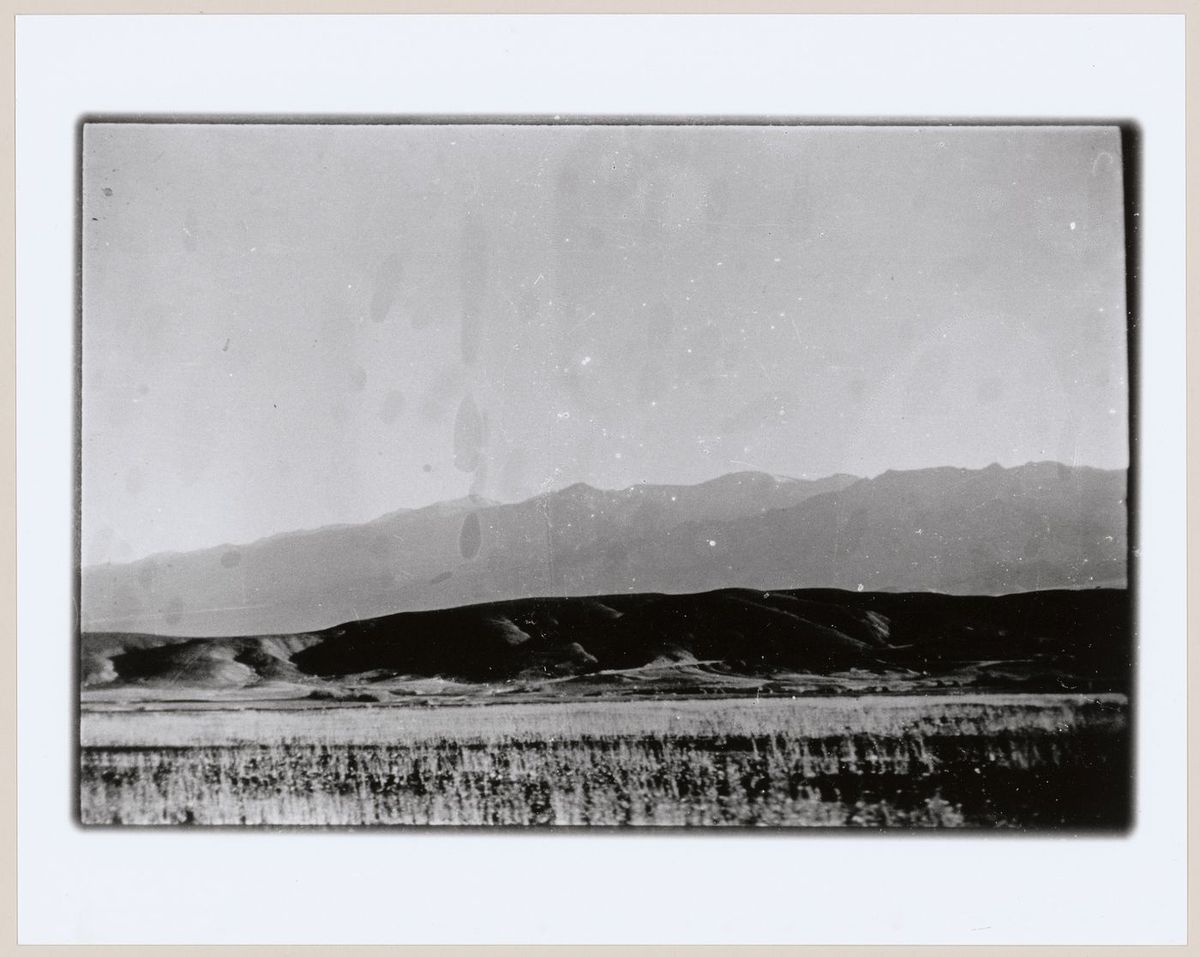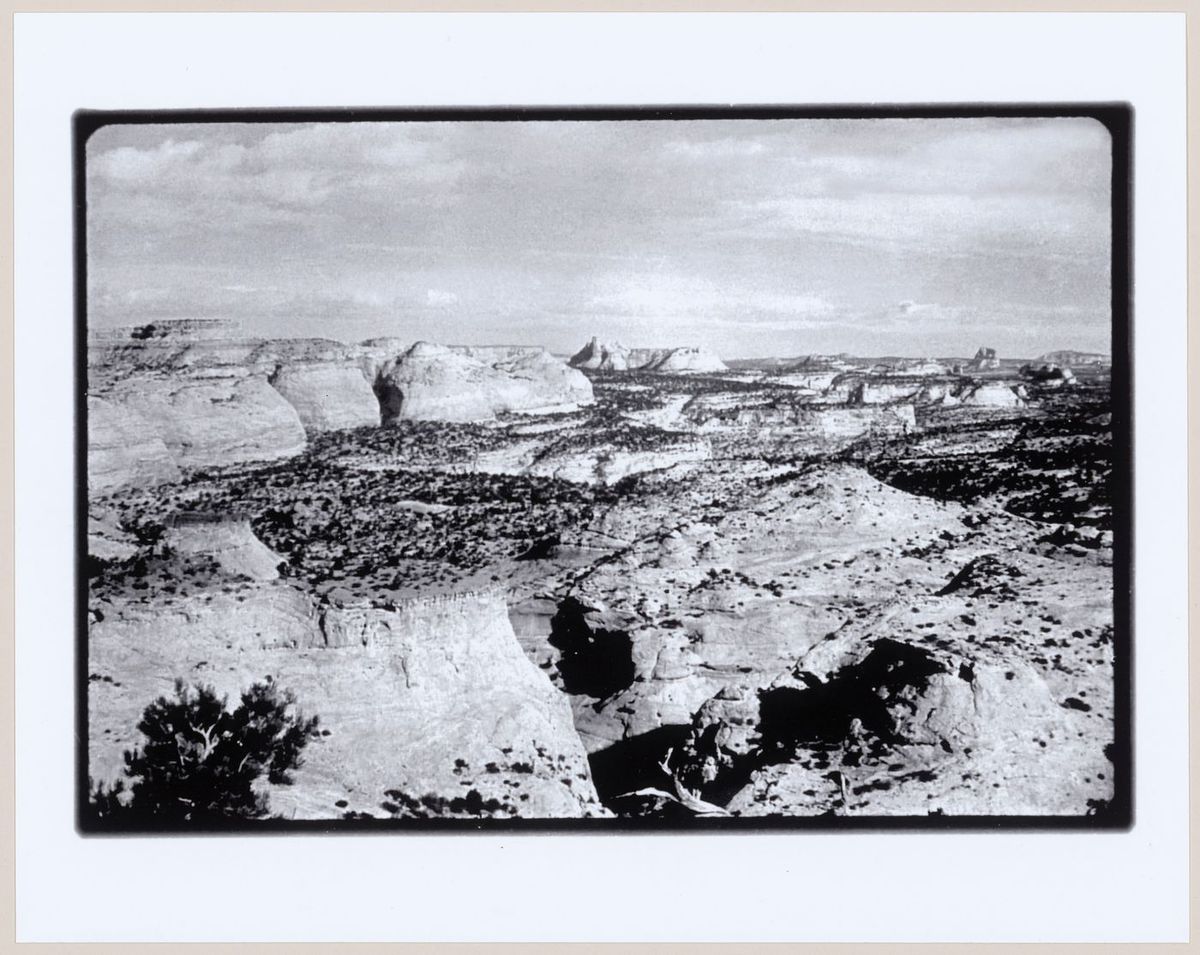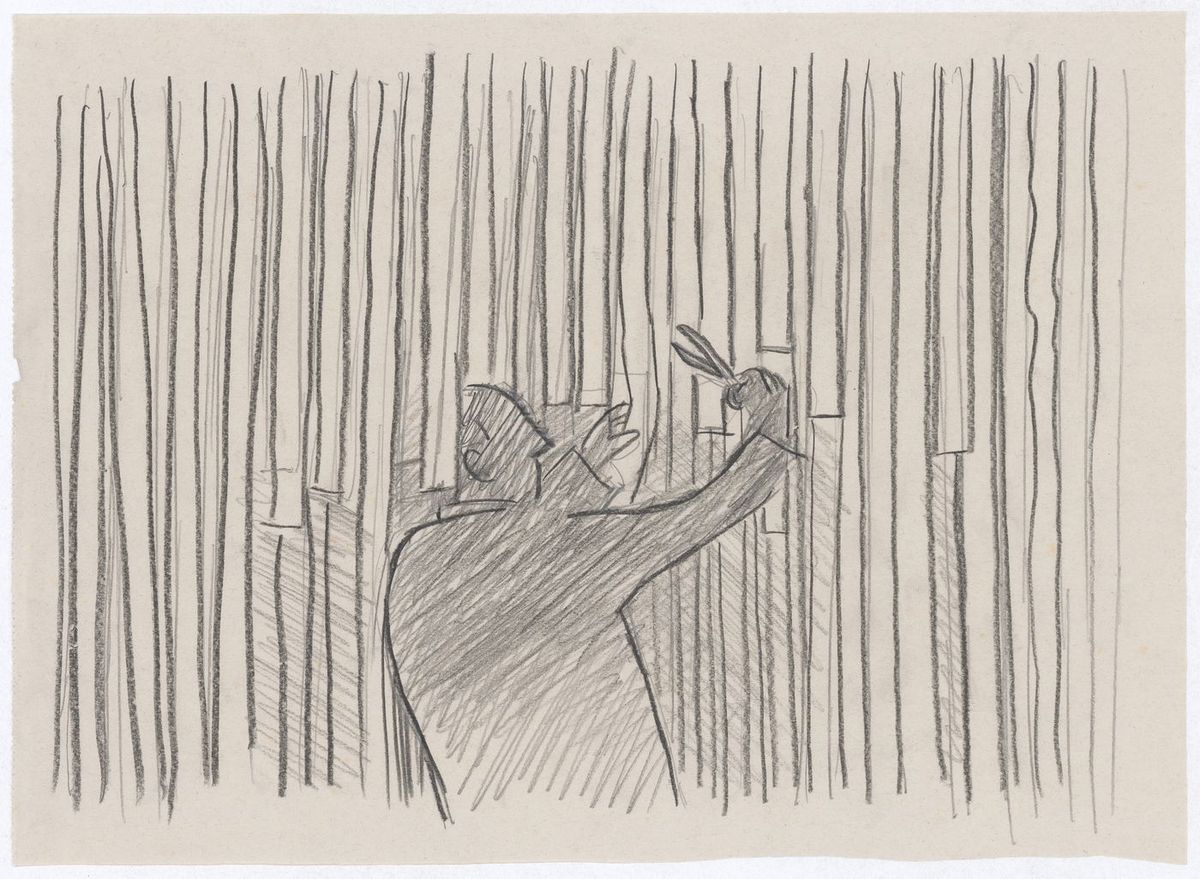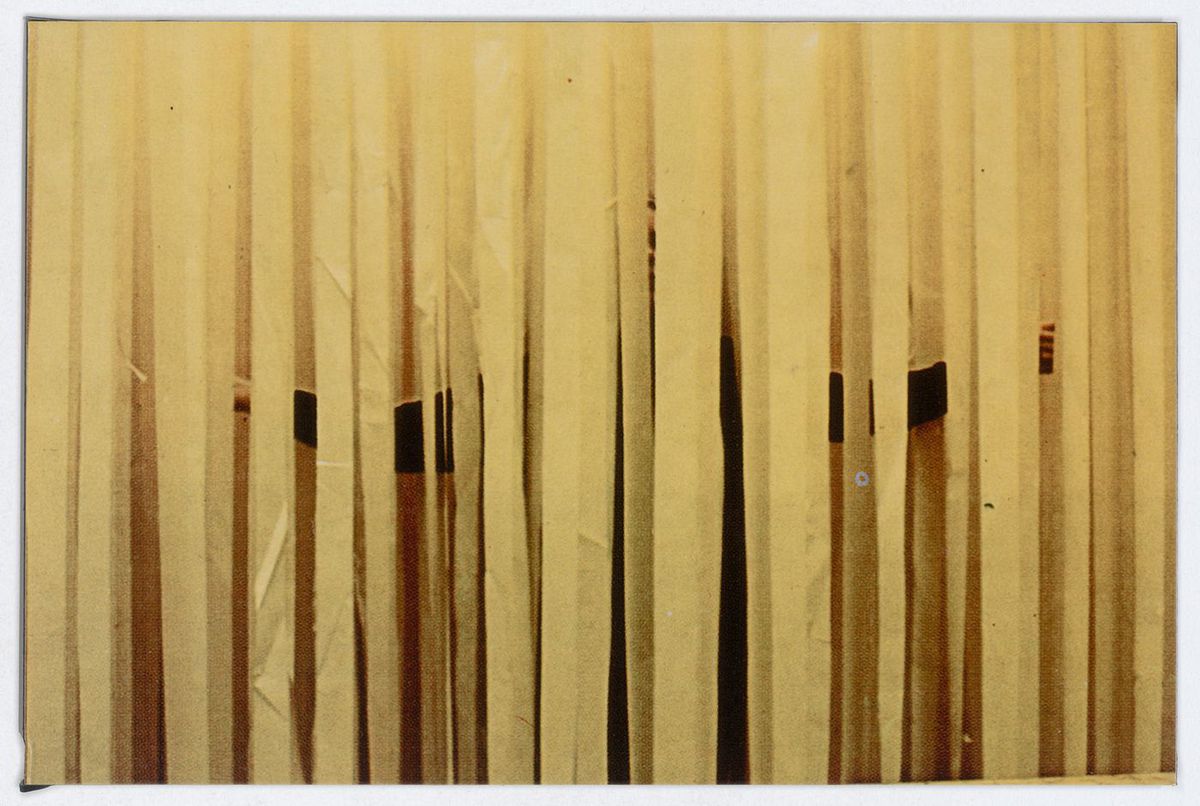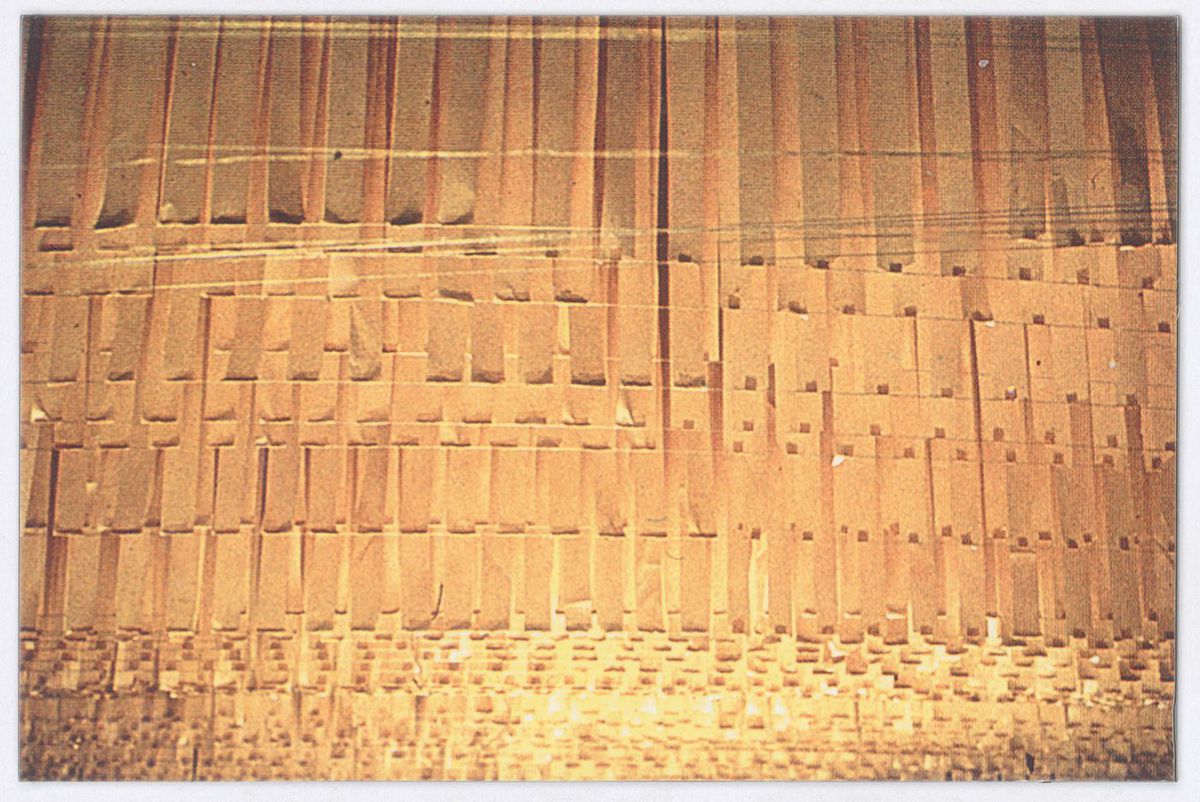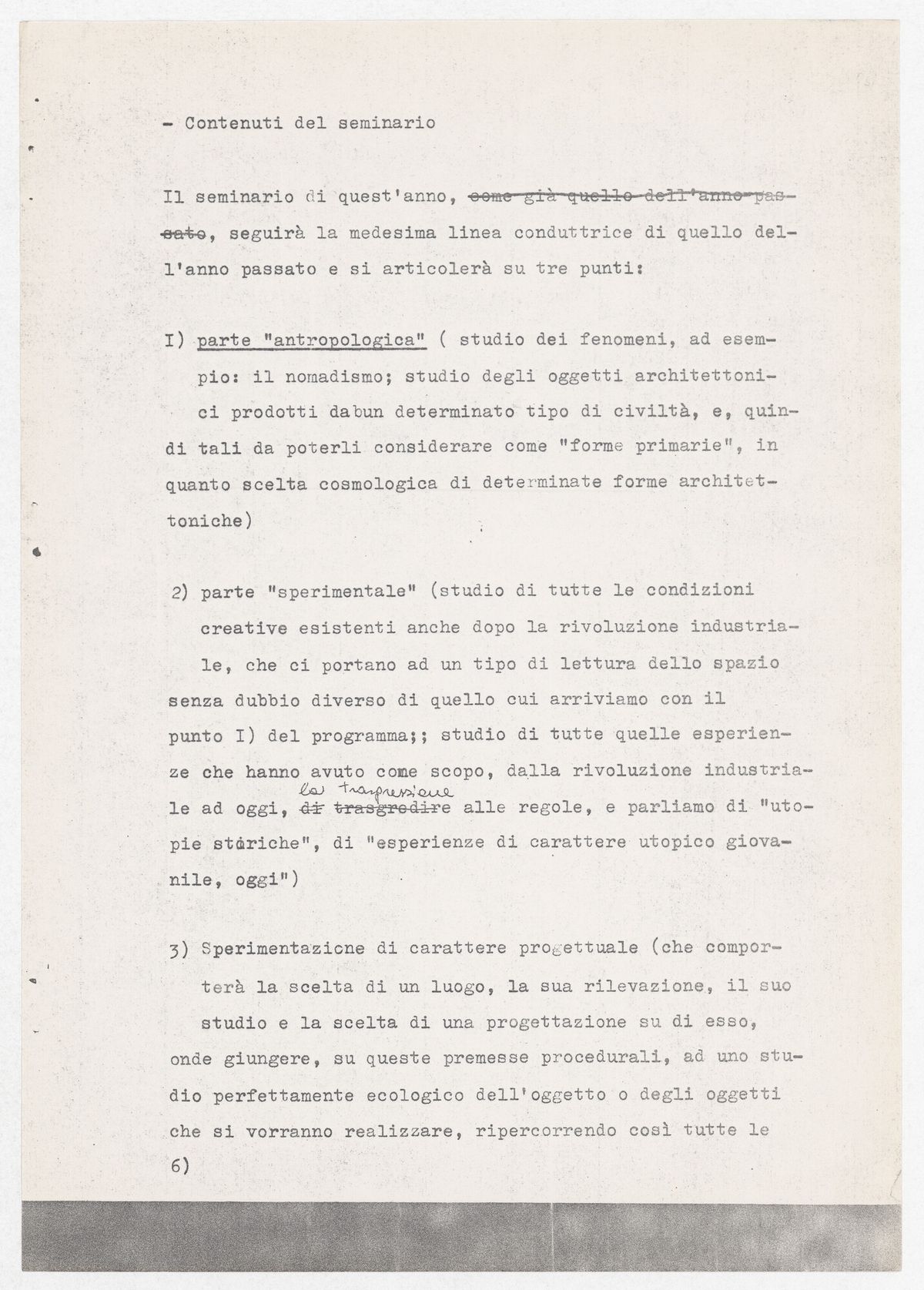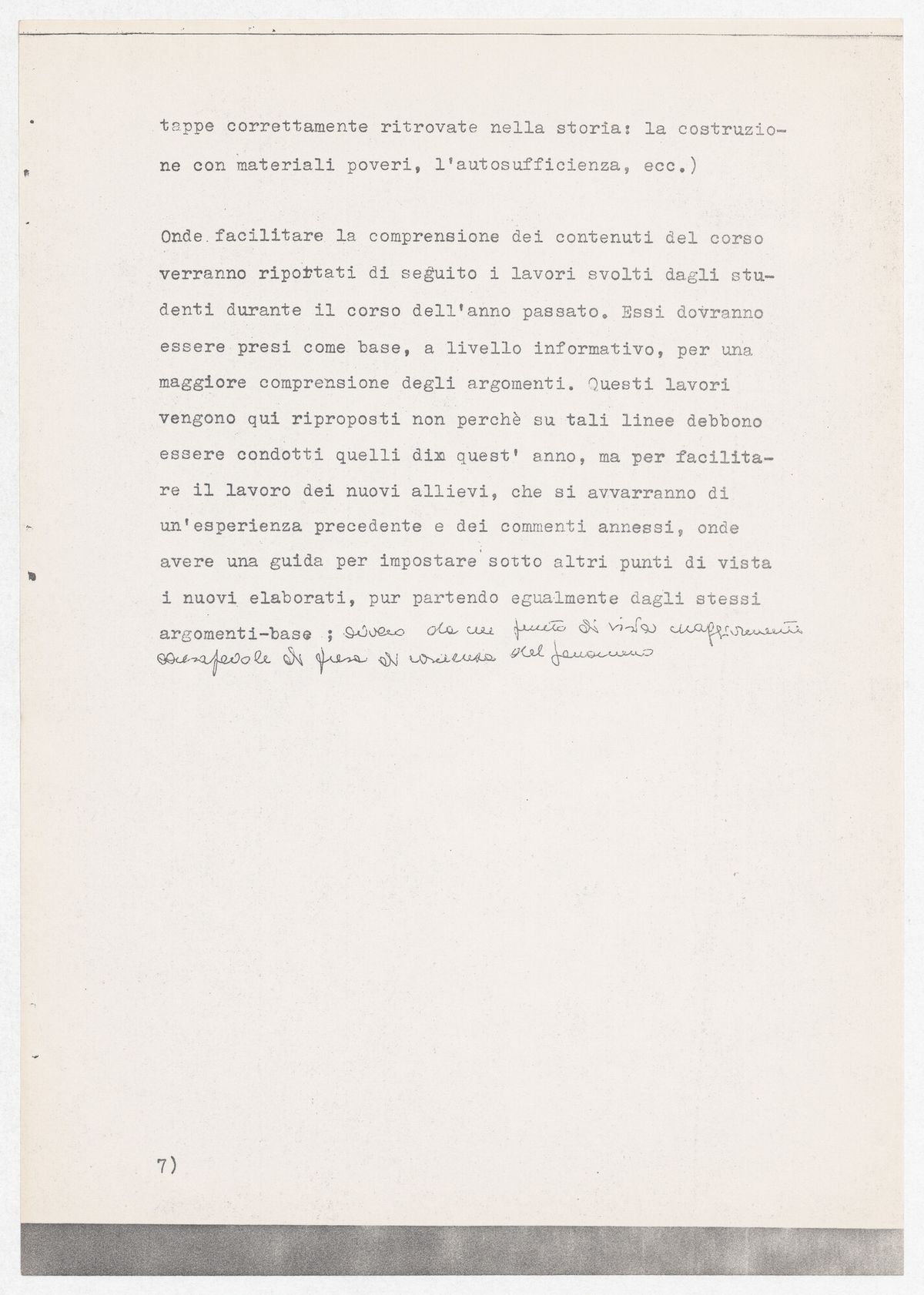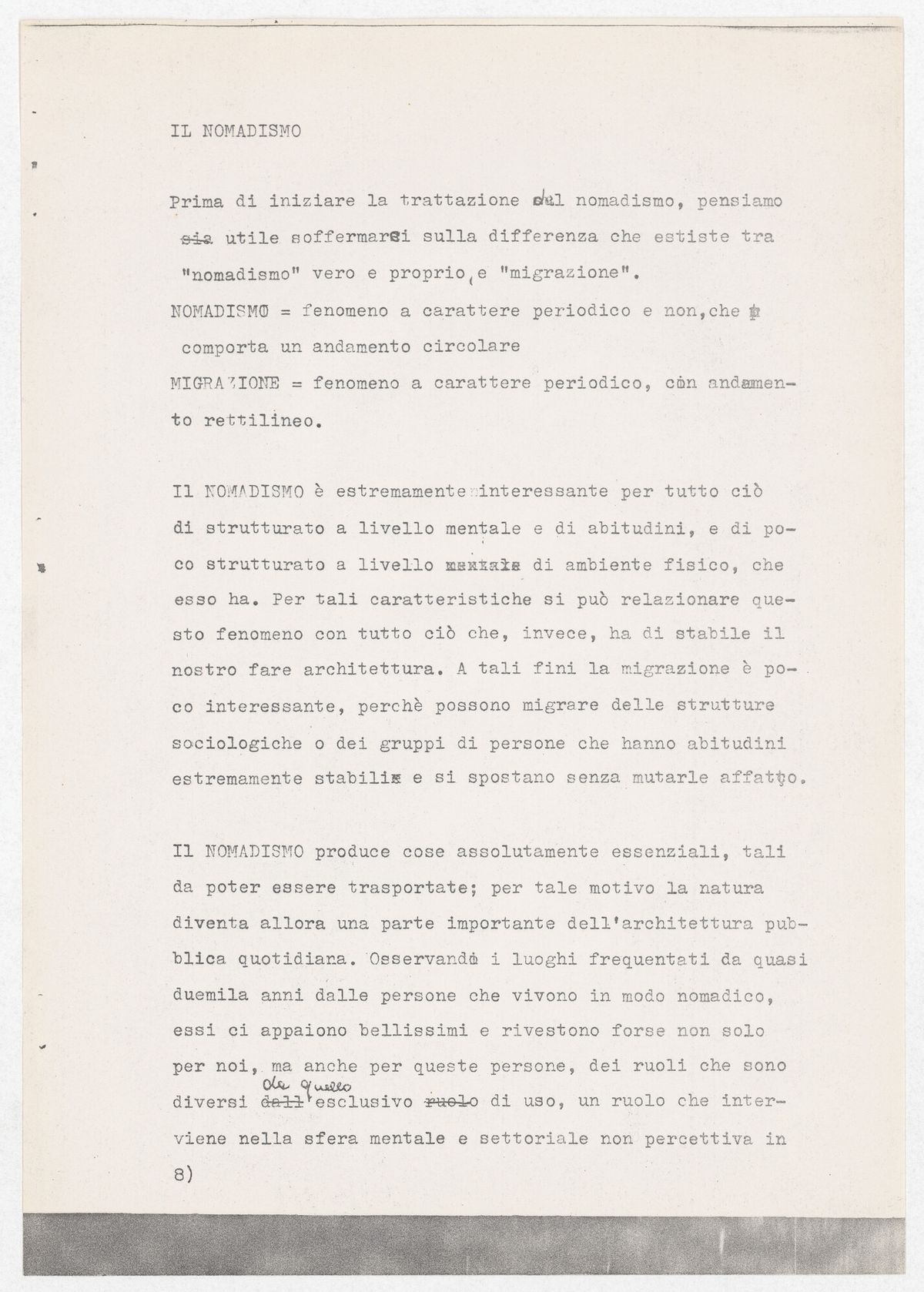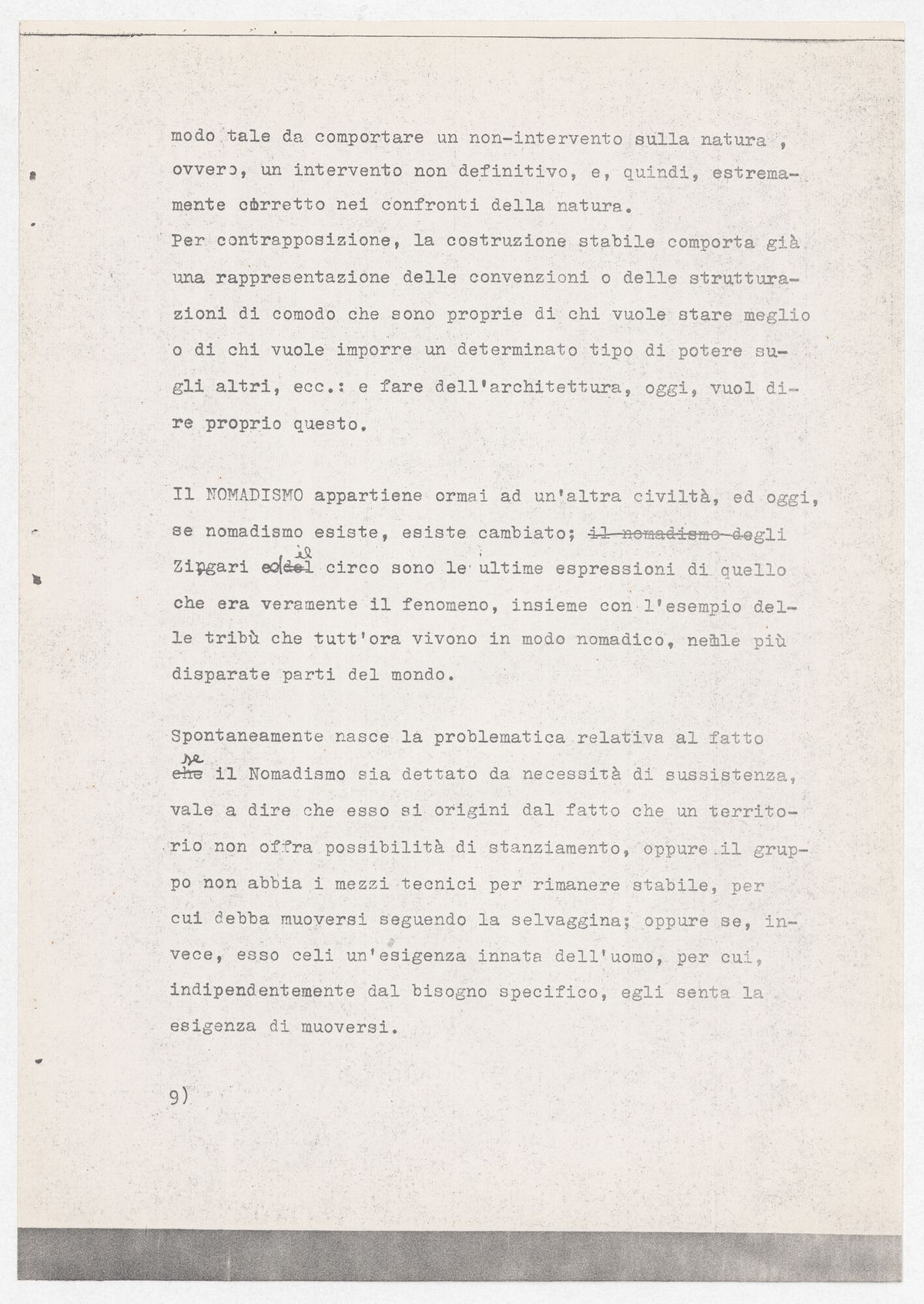Notes for an American itinerary
Elisabetta Trincherini on the Gianni Pettena fonds
The archive of Gianni Pettena, which documents his activity as an artist, theorist, critic, and curator, was moved in 2018 from his home-studio in the hills of Fiesole outside Florence to the CCA. While it is not possible here to provide a complete overview of what the archive contains, it is feasible to construct an itinerary that justifies the presence of these materials in a research centre in North America.
Pettena’s initial work, produced in Italy halfway through the 1960s, stands out for its connection with the Italian political context. Examples include the installations made by hand with corrugated cardboard and metal staples, like Carabinieri (Novara, 1968), a term the artist sees as old-fashioned, poorly suited to any existential reference, and Milite ignoto (Unknown Soldier, Ferrara, 1968). The soldier was actually an Italian killed in action during World War I and buried in Rome at the “Altar of the Fatherland,” and one of the main symbols of nationalist rhetoric under fascism. Although in the republican era he became an apolitical symbol of Italian national identity, politicians and generals continued to use this figure during speeches and ceremonies, displaying a hypocrisy that is targeted by the artist. The third episode of the series is Grazia & Giustizia (Grace & Justice, Palermo, 1968), where the ampersand stands out in a cry of protest against the unjust punishment inflicted on the gay poet Aldo Braibanti. With these works, Pettena spoke out against the disconnect between a society composed of individuals with concrete needs and an obsolete state no longer suited to contemporary mores, especially those of the young generation to which he belonged.
Another “Italian” work of those years, Laundry (Como, 1969), in which a series of clotheslines at Piazza del Duomo acts as a reminder of the fact that the city is a place of social exclusion and injustice and reflects the political dimension of Pettena’s dialectical confrontation with society.
These works came in the wake of Pettena’s only foray into the world of design, though it was not connected with industrial design but with the desire—as the artist put it—to “design life” in all its aspects. This was the project of his own studio, which Pettena imagined and built when he was still a student. He defined it as “his first opportunity of architecture.” In an anomalous architectural space, a volume of 11x7x6 metres with a large window, he invented a series of furnishings, including the well-known Rumble sofa (1967), a soft, squared surface that can be rearranged and utilized in multiple ways and inside which a one-year-old can even learn to walk, as happened to Giulia, Pettena’s daughter.
With Pettena’s move to the United States (1969–70), initially as an “artist in residence” at the Minneapolis College of Art and Design, his work shifts from a political dimension driven by the Italian context to an unfiltered contact with nature, while pursuing the idea of building through subtraction of identity, without using mortar and bricks, but with the tools of thought or of nature—and if the building already exists, it is “renaturalized.” This leads to Ice House I and Ice House II (Minneapolis, 1971 and 1972 respectively), in which a school slated for demolition and a middle-class house are completely encased in ice. Here the addition of a natural material, which due to the low temperatures of winter nights in Minnesota is transformed into ice, restores the monumental impact of an absence. The same thing happens in the large gaps represented by the “cuts” of buildings made by Gordon Matta-Clark. While Pettena constructs through subtraction of identity of the traditional concept of “architecture,” Matta-Clark constructs through subtraction of matter. According to James Wines, they represent the purest and in some ways most poetic spirit of deconstructivism in architecture. Like Pettena, Matta-Clark looks at the typical house of the American middle class in order to deconstruct it with his famous Splitting (1974).1 The two share in a background of education as architects and a practice that goes beyond the boundaries of the discipline and the profession.
The term “Anarchitecture” also brings them together; they coined it separately, though based on the same premises, with Pettena doing so first, unbeknownst to Matta-Clark. Pettena published a book titled L’Anarchitetto (Florence: Guaraldi, 1973), in regard to which he explains his work in these terms: “that type of architecture that finally cannot be distinguished from art.” Matta-Clark invents the name “Anarchitecture” (1975) for a group exhibition of American artists who share in this attitude, and he mentions it in many letters found in his correspondence conserved at CCA, including the note he wrote to Robert Leydenfrost, a consultant for the Art and Design program of the World Trade Center, on 16 January 1975.
-
James Wines, “Gianni Pettena radicale gentile,” in Gianni Pettena (Milan: Silvana Editoriale, 2002), 36 ↩
Another definition provided by Matta-Clark for his own work seems equally applicable to the practices of Pettena: “My idea is to find an abandoned building or one ready for demolition and do some nonarchitectural revisions on it” (see the letter to James Harithas, Museum of Contemporary Art, 21 January 1975).
The compression to the point of erasure of the function of human shelter to suggest other functions is also the theme of the Clay House (Salt Lake City, 1972), another standard middle class dwelling that Pettena subtracts from its block, making it disappear (as had happened with the ice) thanks to a thick layer of clay that covers it entirely, including the windows. It becomes impossible for human beings to live inside it, but not for insects which find homes inside the cracks that form as the clay dries.
Another renaturalization is that of the Tumbleweeds Catcher (Salt Lake City, 1972), while in the important series of photographic images titled About Non-Conscious Architecture (Arizona and Colorado, 1972–73) Pettena catalogues “not made by architects architectures” surveyed during the course of his travels in the United States in that period.
As through the principle of communicating vessels, Pettena’s activity as a theorist and critic influenced his artistic practice, and vice versa. One project that was realized halfway through the 1990s, but whose conception dates back to the early 1980s (the correspondence in the archive offers extensive proof) is the examination, through a large exhibition at the Uffizi in Florence dedicated to Frederick Law Olmsted (1822-1903), the inventor of landscape design as a profession (as opposed to “landscape gardening”), even prior to the very concept of the urban park. The variegated documentation in the archives shows how Pettena approached this subject, studying everything that existed in published form about Olmsted, in Italian and English, and contacting the Olmsted Foundation to see the original drawings, which he requested on loan for the exhibition. From his notes, prepared on the basis of his studies and then partially included in the exhibition catalogue, Pettena enumerates the principles involved in the design of the environment, which include the fact that landscape design must be based on social analysis and has to produce greater equality among citizens in order to be necessarily democratic. Furthermore, it has to see cities as indispensable vital centres of culture and civilization, while acknowledging that any alteration of natural processes, no matter how small, has profound consequences on the ecology of the surrounding area. Pettena points to the necessity for environmental design to be conducted by a multidisciplinary team of experts on social and nature sciences, architecture, and engineering, without interference on the part of politics. In his notes, Pettena covers the “healthy” impact Olmsted sought on the entire human organism, and implies that the scope of design should not be limited to creation and decoration, but should also consider its utility in relation to the needs of human beings. In his practice as an artist and a designer, Pettena is one of the first and most convincing followers and exegetes of Olmsted’s idea that the greatness of the American nature stems from its natural heritage.
As a critic, Pettena was fascinated by the idea of acquainting Italy, and especially Florence (a city that has always focused on the Middle Ages and the Renaissance), with the most advanced positions in the contemporary architectural debate. Once again, this means looking to the United States for reflections on “Whites vs. Grays,” namely the disciples of the Modernist heritage and those who, starting with Learning from Las Vegas, welcomed vernacular contaminations. The results were two exhibitions at the Accademia delle Arti del Disegno in Florence, on Richard Meier and Robert Venturi.
In an unpublished conversation between Pettena and Meier, held in the archives, we can observe opposing positions on art: while Meier asserts that “the meaning assumed by every architectural achievement has to go beyond the contemporary or a contingent ideology, art that is too connected to its moment does not have great meaning,” for Pettena it is necessary to use “a language that goes beyond the practical functions required of the architect” (Richard Meier in conversation with Gianni Pettena, 13 December 1981).
But what fascinates Pettena is probably Meier’s position with respect to nature, reflected in the handling of colour in his projects. “In all the spaces in which there is no life reflected from a natural setting, I try to make widespread use of colour, in a differentiated way” (see, for example, the Bronx Development Center) […] but in the spaces in which the life of nature intervenes and penetrates, to me color seems artificial and not necessary” (Ivi). And here the examples abound in the many works of architecture for private clients, which are white and immersed in nature, from the Smith house to the Old Westbury house.
Pettena’s teaching activities are also of specific interest. Still in the United States, these activities stand out for the involvement of his students in performances—a central aspect of the artist’s work—such as the Wearable Chairs (Minneapolis, 1971) and in installations like Paper/Midwestern Ocean (Minneapolis, 1970).
Back in Italy, Pettena again involves students in the production of a workshop for study and application of alternative technologies, whose program includes activities like recycling of organic waste, the treatment of drinking water, the use of wind energy, etc. He also supports and nurtures a “vertical seminar,” a student-run space that utilizes the resources present in the school in terms of places, materials, and professors. In this space, Pettena is able to host talks by some of the most outstanding exponents of contemporary art, including the Americans Chris Burden, Terry Fox, Bill Viola, all passing through Florence, and Italian artists like Boetti, Merz, and Kounellis.
Finally, the syllabi of the courses conducted by Pettena at the University of Florence, as documented in the programs conserved in the archive, reveal a central focus on themes like the experimentation in California in the 1960s, and in New York in the 1960s and 1970s. Other topics include nomadism and the history of architecture—and particularly of those who produce objects not by culture, but “by necessity.” Spontaneous architecture is not just that of primitive eras; for Pettena, it arises every time that humans, in constant relation to nature, are able to improve their conditions of survival, going through conscious growth on a cultural level. This is demonstrated by the study and transferal of authors like Bernard Rudofsky and Victor Papanek.
The theme of the non-architect, people who build by necessity and for themselves, in relation to nature, is also central in the correct re-attribution of Casa Malaparte to its original maker and owner.
Elisabetta Trincherini was in residence at CCA in January 2023 as part of Find and Tell, a program that promotes new readings that highlight the intellectual relevance of particular aspects of our collection today.
